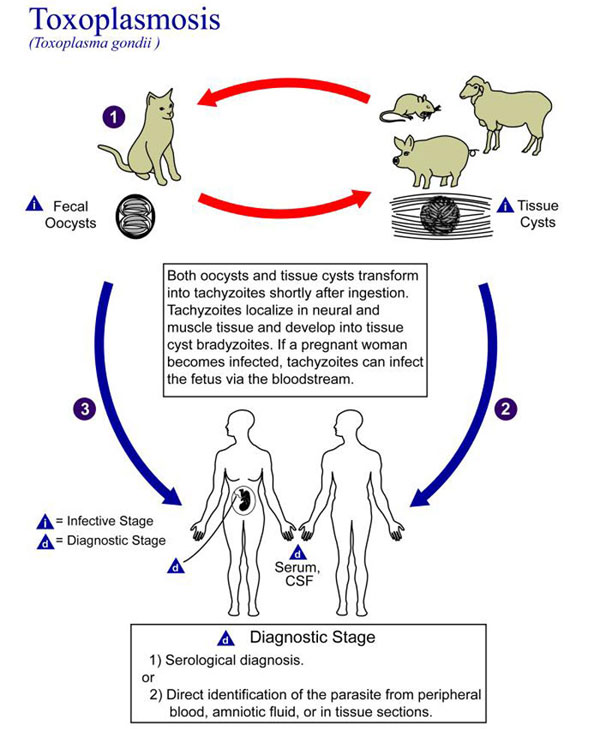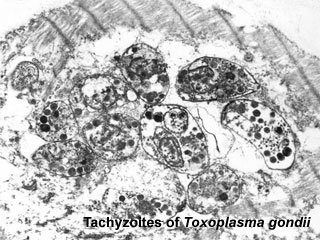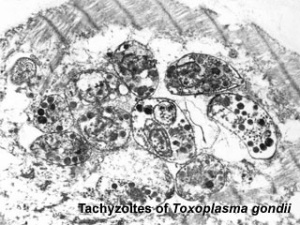Introduction
The causal agent of Toxoplasmosis is the protist Toxoplasma gondii. This unicellular eukaryote is a member of the phylum Apicomplexa which includes other parasites responsible for a variety of diseases (malaria, cryptosporidiosis). The diagnosis and timing of an infection are diagnostically based on serological tests.
Recent findings suggest that pre-pregnancy immunization against toxoplasmosis may not protect against reinfection by atypical strains.
Some Recent Findings
- Seroprevalence of TORCH infections in women of childbearing age in Croatia.[1] "During 2005-2009, a seroepidemiological study was carried out in Croatia to define the population susceptible to common TORCH agents among pregnant and non-pregnant women of childbearing age. The IgG seroprevalence was 29.1% forT. gondii, 94.6% for rubella, 75.3% for cytomegalovirus (CMV), 78.7% for herpes simplex virus type 1 (HSV-1), and 6.8% for HSV-2. Acute toxoplasmosis and CMV infection (positive IgM antibodies with low IgG avidity) were documented in 0.25% and 0.09% women, respectively. IgM prevalence was 1.2% for both HSV-1 and HSV-2. None of the participants showed acute rubella infection. Seropositivity to T. gondii and HSV-2 varied significantly between age groups (p = 0.001 and p = 0.036, respectively). Women residing in rural regions showed a significantly higher seroprevalence rate for T. gondii, CMV, and HSV-1 than urban women (T. gondii: 44.0% vs. 25.4%, p < 0.001; CMV: 85.0% vs. 73.1%, p = 0.018; HSV-1: 86.0% vs. 76.4%, p = 0.041)."
- Routine TORCH screening is not warranted in neonates with subependymal cysts.[2] "Congenital infections are associated with a wide variety of clinical symptoms, including subependymal cysts (SEC). ...The co-occurrence of TORCH congenital infections in infants with SEC is rare. Routine TORCH screening in neonates with SEC does not seem warranted."
|
Toxoplasmosis Lifecycle

Toxoplasma Tachyzoites

Glossary Links
- Glossary: A | B | C | D | E | F | G | H | I | J | K | L | M | N | O | P | Q | R | S | T | U | V | W | X | Y | Z | Numbers | Symbols | Term Link
Cite this page: Hill, M.A. (2024, April 26) Embryology Abnormal Development - Toxoplasmosis. Retrieved from https://embryology.med.unsw.edu.au/embryology/index.php/Abnormal_Development_-_Toxoplasmosis
- What Links Here?
- © Dr Mark Hill 2024, UNSW Embryology ISBN: 978 0 7334 2609 4 - UNSW CRICOS Provider Code No. 00098G
- ↑ <pubmed>20476874</pubmed>
- ↑ <pubmed>20227842</pubmed>


